COVER- Has Charlottesville jumped the shark?
Inevitably, there comes a time when the popularity of a thing is undone by its popularity. Even the Beatles, arguably the greatest entertainers of the 20th century, were not immune. One could argue that they broke up because their popularity wouldn't allow them to exist.
"The whole pressure of it finally got to us," John Lennon said. "By the time we got to Let It Be, we couldn't play the game anymore, we couldn't do it anymore." So it ended on the rooftop of the Apple building in London with the cops telling them to turn down the dang music.
Indeed, our celebrity-obsessed culture is a graveyard of dreams that flew too close to the sun. Richard Nixon won the 1972 presidential race in a record landslide, but wasn't it really the beginning of the end? Who would have imagined a sports star as celebrated and accomplished as O.J. Simpson falling so far? Or that the singer who put out Thriller in the '80s, making him the literal golden boy of pop, is even the same person we know today? Remember when Britney Spears was the "it" girl? Or that Boy George was the icon of the '80s? Or when Pee-wee's Playhouse was the most popular kids' show on television?
Obviously, being popular can be perilous, and the peril often grows with the fame. In the 1970s, the TV show Happy Days was the most popular show on television, and its star, Henry Wrinkler as "the Fonz," was the epitome of cool. But then he jumped the shark.
When fans saw the episode where their hero– normally sporting a leather jacket and jeans and leaning against a motorcycle chatting up some babe– leaps over a shark on water-skis in his shorts (and leather jacket), well, the spell is broken.
Twenty years later, the phrase "jump the shark" turned up as a definition of the moment when the popularity of a thing, having reached its apex, sputters like a rocket out of fuel and begins its decent into history's dustbin.
So, has Charlottesville jumped the shark?
As we all know, Charlottesville's growing popularity over the last decade has led to some big changes in our little 'ville. Like our homegrown rock stars, the Dave Matthews Band, whose rise to fame occupies nearly the same time frame, we've come a long way from those open mic nights at Eastern Standard; from a bartending job we could survive on; from those intense, dream-soaked talks over bourbon and cigarettes at Miller's; from stumbling half-drunk down the deserted Downtown Mall– which was as isolated as a ghetto from the rest of the town— to a house party in Belmont or home to a big room in an old house that cost only a few hundred a month.
At the time, who could have imagined our sleepy town was ripe for such changes? That the band at those open mic nights would eventually outdraw the Rolling Stones? That the $50,000 bungalow on Altamont Street would be worth seven or eight– or nine!– times that much? That the Downtown Mall would attract so many happy teenagers, UVA students, professionals, tourists, and moms with their strollers? Or that Charlottesville itself would blossom into one of America's favorite places to live?
"The town is now a completely different place than the one I lived in when I was a kid," says Charlottesville native Kevin Cox, who grew up here in the '60s and '70s. " It's like I moved away, but really I didn't move. The town vanished, and a new mini-city moved in."
Indeed, Charlottesville's national recognition and its emergence as #1 city over the last decade has prompted some preening. Who among us hasn't referred to one of those top rankings in Frommer's, Money, Newsweek, Organic-Style, or Outside to a distant family member or faraway friend? Or casually rattled off our growing list of urban pleasures to a visitor: the coffee shops, restaurants, theaters, art galleries, organic grocery stores, music venues, festivals, shopping centers, boutiques? And who among us didn't secretly feel like Charlottesville was the center of universe when the Stones came to town?
"It's a more interesting place to live than it used to be," says Richard Guy Wilson, UVA's architectural history department chair, who moved here in 1976. "There are so many good restaurants now, bookstores, things to do, interesting people coming to town."
Still, Wilson worries that the "horrendous sprawl" in the county could "zap" the vitality of downtown. He's also concerned about the way "new urbanism" development projects are changing our streetscapes.
"I'm all for filling in the empty lots," Wilson says, "but the size and form of these things change the streetscape, change it from a village to a town to city."
In response to these changes, he also thinks the city has been "oblivious" to parking issues. Finally, he wonders if we might be driving out the "mix" that has made Charlottesville so interesting with high-end housing.
Indeed, as a recent market analysis by area realtors revealed, the number of houses for sale in the area has doubled since the same time last year to 2,377. In addition, the price of those houses has skyrocketed. The median price of a home in our market area is up 27 percent– to $285,000– from last year, and in Albemarle County alone the median price has risen to $339,000, up a whopping 47 percent from last year.
What's worse for normal folks is that precious few houses are huddled around the median. A quick search on a local real estate database reveals only around 70 of the 294 houses listed for sale in Charlottesville under $250,000; in the county only about 140 of the 752 for sale are under $250,000.
Given the fact that Charlottesville's population has remained the same (hovering around the 40,000 mark) while housing stock has doubled, it's safe to assume that people are cashing out– and handing Charlottesville over to newcomers who can afford it.
In fact, according to the U.S. Department of Commerce Bureau of Economic Analysis, overall personal income in the Charlottesville area rose 7.9 percent between 2003 and 2004, more than any other area in Virginia. Maybe those of us living here are simply making more. Maybe not.
In the county, population figures have risen about 10,000 since 2000, according to the U.S. Census Bureau– providing some justification for all the recent and planned development– but it's looking like Charlottesville's popularity could indeed be driving out the income mix that helped make it so popular.
Of course, that's to say nothing about the sheer ambition of some development projects. Biscuit Run, a 1,353-acre tract just south of town on Old Lynchburg Road, could be rezoned under the county's Neighborhood Model, a new urbanism initiative that calls for denser development. Biscuit Run might accommodate between 2,500 and 4,000 new houses becoming a veritable city complete with its own elementary school. And on the corner of Hydraulic and 29, plans are afoot to build yet another "town center" that could be twice the size of the Downtown Mall.
Of course, development and skyrocketing housing prices are the obvious result of our popularity, and perhaps the most insidious way we might jump the shark. After all, if none of us can afford to live here, or if everyone moves out of town, who'll be left to even notice we've become passe?
Other factors…
Of course, one could argue that Charlottesville jumped the shark when Jefferson moved to town, or as blogger Anne Metz (a.k.a CoolHoney) theorizes, "I suppose it's all a matter of perspective. Hatersand Native Americans will say that Charlottesville jumped the sharkalmost 250 years ago, when the city was chartered in1762 along Three Notch'd Road."
Fellow blogger and uber-citizen Waldo Jaquith takes a similar tongue-in-cheek approach.
"Y'know when Charlottesville jumped the shark?" he says. "March 3, 1865. That's when UVA Rector Robert Preston surrendered Charlottesville to General George Custer. What the hell was that?He had no business surrendering the town to a bunch of blue-breeched dandies. Everything since then has been totally lame."
Of course, 20-somethings Metz and Jaquith are poking fun at the question, but as Metz aptly observes, it is a matter of perspective. After all, doesn't every new generation make a place "new" and "cool" simply by being there, despite all the grieving they hear from old-timers? And what are we to make of residents of new cul-de-sac neighborhoods Mill Creek or Dunlora whining about growth? (Their neighborhoods weren't even here 15 years ago.) Who gets to decide when Charlottesville has jumped the shark?
"People have been bemoaning the loss of the sleepy little town, C'ville, probably since Reconstruction," says 40-something Charlottesville resident Ted Corcoran, who moved here in the late '80s. "I remember the Vinegar Hill theater once begged people to come to McCabe and Mrs. Miller by saying, 'C'mon Charlottesville, this used to be your favorite movie.' So, looking back in fondness for old times has probably afflicted anyone who has been here more than 10 years."
Corcoran cites the extinction of the "Albemarle Hippie" as a potential jump-the-shark sign. "It was a species forged in the '70s and '80s of jeans, flannel shirts, and moonlight nights," he says. "They were students, or just out of college, with little or no marketable skills."
Corcoran says there seemed to be more carpenters living in little country cottages, often feeding woodstoves, drinking bourbon, and smoking cigarettes. "The life was good, the talk intense, the dreams still just beyond the fingertips," he says. "You could tend bar at night and have plenty left over for carousing, or living on next to nothing, starving for art. And there was always grad school."
A decade later, Corcoran notices a new species. While strolling the Downtown Mall with a pair of married college friends visiting from New York, who were staying at the Omni and had already visited Monticello, he says, the woman professed to be "so charmed by your little town."
"It was so clear to me that these folks were the kind of people moving here," says Corcoran. "They have kids just short of the ages when moving is not a good idea. He has a job that depends on a computer, and traveling and can be done anywhere. She does yoga and has an artistic bent. In short, they seemed the embodiment of this new Charlottesvillian species."
Perennial gadfly Matt Farrell takes a more pop cultural approach to the jump-the-shark question, saying that downtown Charlottesville's cultural "golden age" ended about the time the Dave Matthews Band hit it big.
"What ails Charlottesville is what ails generation X," says Farrell. "Anything interesting about that generation ended about when Kurt Cobain killed himself. That's certainly when Dave Matthews hit, when C'ville began to lose all of its makeshift/bohemian flavor in favor of world-beat, world-news, world-trends." After that, says Farrell, "It was all mass-market, Starbucks, the Internet, and breeding."
Farrell also laments the loss of Charlottesville's Southern flavor, the "small-town community lazy good manners of the South," as he puts it.
"I think it was in 1995, around March or April, when I first stopped someone on the Downtown Mall and dressed them down for not responding to a 'Good morning!'" Farrell says. "It's the death of that simple sense and function of community– the commonality of experience, and fellow-traveling though a small town, that I think was the end of most of what was best about Charlottesville back then."
Indeed, former resident Bruce Ponman, who moved to St. Louis several years ago, says he left Charlottesville because the "sleepy southern town" he grew to like in the early '90s wasn't the same.
"The day the old Fellini's closed was some sort ofwatershed for me," says Ponman from Missouri. "I've heard that traffic has gotten much worse, it's harder to get a tee time, and housing is a problem. I imagine it's grown much more difficult to keep the 'genteel' in a life of genteel poverty– in other words, it's starting to feel more like New York or California."
Still, Ponman expresses something that many of us feel, despite the enormous changes in the last decade.
"Having voiced several complaints," he says, "I should add that I'd move back soon enough if I could afford to buy a place, traffic or no traffic. But of course I'd want to live downtown."
So, has Charlottesville jumped the shark? If Ponman's answer is any measure, we may still be of two minds about that. And, of course, it all depends on whom you ask.
"I don't think Charlottesville has jumped the shark," says Kevin Cox. "There may be shifts in the type of people Charlottesville is popular with, but it will remain popular. In spite of a growing population and increasing traffic congestion, a lot of people still think it's a cool place to live and will move here. In fact, it may even be getting cooler as the number and quality of restaurants and entertainment venues and the ranking of UVA sports teams improve."
Although Metz admits that Charlottesville has changed a lot since she moved here in 1999, even as she refers to it as "C-Vegas," she's soothed by its urban pleasures.
"I can eat Cuban sandwiches whenever I want," she says. "I can get the Thursday style section of The New York Times delivered to my home each week. We've got the NYC Shuttle to dump me off in the meatpacking district in under six hours. And the Bad Trax has been razed."
Apparently, Metz is also soothed by our present mayor, whom she has praised for something called his "dopeness" on her blog. "I would also argue that His Dopeness, Mayor David Brown, has done a lot toun-jump the shark," she writes.
However, for those of us who have been here longer, who've seen just how much the town has changed since the Farrell-defined "golden days," there has always been an odd and nagging parallel between the DMB's success and the town's growth. That's because the band's immense popularity, and the town's, has had the strange effect of turning locals who witnessed the DMB's birth at Trax (the good Trax, as Metz would say) and the town's many changes, who might have imagined themselves a part of something special, into groupies against their will.
Who among the old-timers hasn't shared a DMB story without feeling an odd mixture of pride and self-loathing? Yeah, I'm from Charlottesville, and yeah I know Dave, or Boyd, or Carter, or Stephan, we say to the wide-eyed fan. But the memory isn't ours anymore, and it isn't special.
Like Charlottesville, it belongs to everyone now.
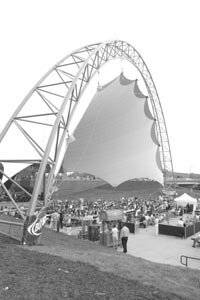
The Pavilion: Love it or hate, the Charlottesville Pavilion has altered the streetscape of the Downtown Mall in dramatic fashion. Some think the small-town flavor of Friday's After Five has been lost because of it, others think it's a cool new music venue. Some say it even looks like a shark? Or is it a lobster?
PHOTO BY HAWES SPENCER
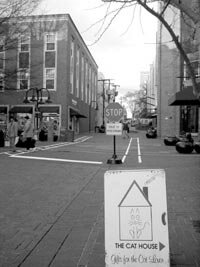
Mall Crossing: We knew the Downtown Mall, a pedestrian thoroughfare after all, was getting popular when the first car crossing went in. Now there are plans for another. Anyone wanna place bets on the first hit-and- run?
PHOTO BY COURTNEY STUART

Albemarle Place: When the county dreamed up the Neighborhood Model, which calls for denser development, they certainly weren't talking about Mister Rogers Neighborhood. Imagine this: a town center more than two times the size of the Downtown Mall.
PUBLICITY PHOTO
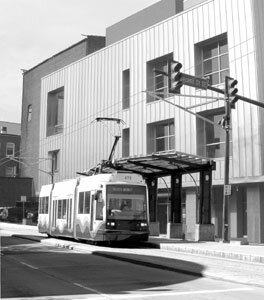
The Streetcar proposal: How do you transform a small southern college town into a city? Put in a fancy street car! Many feel this San Francisco treat (or is it Seattle?) is just what the city needs. Others think it's a sure way to jump the shark.
SIMULATION PHOTO
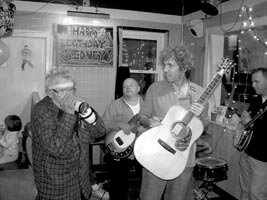
Blue Moon Diner: When the Blue Moon Diner closed, so did the last scrappy homegrown music venue and true diner. Where else can you smoke a cigarette over your scrambled eggs? (Here, the Hogwaller Ramblers help Sidney Tapscott celebrate his 80th birthday, circa 2003.)
PHOTO BY ?
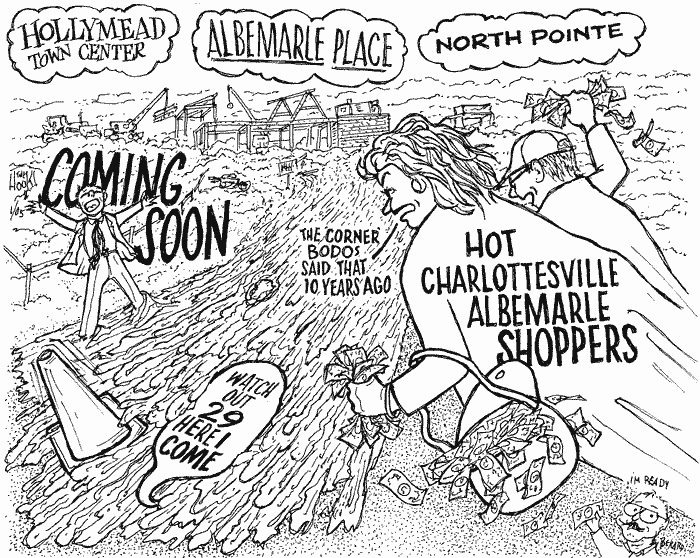
Mega-development: When developers cleared the land for Hollymead Town Center, it looked like a nuclear bomb had exploded along 29 North. But it was only the beginning of explosive development in the county.
CARTOON BY DON BERARD
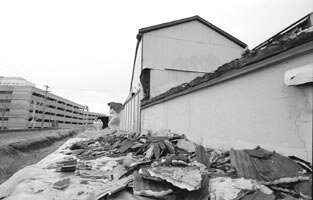
Trax nightclub: Trax, the music venue where the Dave Matthews Band was born, is demolished. Some say the music scene in Charlottesville is better than ever, but others say it's never been the same since the DMB began casting their long shadow.
PHOTO BY JEN FAREILLO
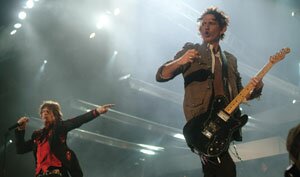
Mick & Keith get rained on: Think it was a big deal when the DMB played Scott Stadium? What about when the Rolling Stones played there! In all the hype and excitement, did we unknowingly witness a jump-the-shark moment? Are we permanently spoiled? Will any other event in town excite us as much?
PHOTO BY MITCHELL JARRETT
SIDEBAR- Potential "jump the shark" moments in Charlottesville history
As you'll see from the list that follows, Charlottesville has had plenty of possible "jump the shark" moments in its history. Notice how such moments accelerate in recent years. Sadly, many locals conclude that the shark has indeed been jumped.
1743 Thomas Jefferson born in Shadwell
1762 Town chartered along Three Notch'd Road
1865 UVA Rector Robert Preston surrenders UVA/Charlottesville to 25-year-old Union General George A. Custer
1959 Barracks Road Shopping Center opens
1974 City Council votes to make Main Street the "Downtown Mall"
1983 End of Easters
1988 Fridays after Five debuts
1990 Garth and Earlysville Roads are fast becoming suburbs
1991 Federal agents seize three UVA fraternity houses as drug havens
1992 Dave Matthews Band graces cover of C-ville Weekly
1993 Original Hogwaller Ramblers implode
1994 Fellini's closes
1995 Sam Shepard and Jessica Lange leave town
1995 Strangers stop saying "Good morning" to Matt Farrell
1996 Regal Cinema sixplex opens downtown
1996 First Downtown Mall auto crossing opens
1996 Williams Corner Bookstore closes
1997 Woolworth's closes
2001 Dave Matthews Band graces cover of Rolling Stone
2001 Dave moves to Seattle
2001 Neil Young opens for DMB at Scott Stadium
2002 Trax is demolished
2002 Main Street Market opens
2002 "Balsamic reduction" seeps onto all downtown menus
2002 Pantops Mountain becomes Rivanna Ridge
2003 John Casteen exiles Pep Band from games
2003 Live Arts moves to designer building
2004 Brown's Mountain "kite day"flies away
2004 A Frommer's "best places" book calls Charlottesville #1
2004 Ryan Homes buys up much of Old Trail Village in Crozet
2004 Restaurant trash begins crowding downtown streetscape
2004 A house in Belmont tops the $400,000 mark
2004 Coran Capshaw buys old SNL HQ and other buildings
2004 Paramount Theater re-opens
2005 Holsinger luxury condos rise in old C&O parking lot, obliterating Toxeol sign
2005 Caspari paper boutique opens in Woolworth's site
2005 Biscuit Run farm sold for development
2005 Authorities announce stoplight synching for Rt. 29
2005 Coran Capshaw opens Charlottesville Pavilion
2005 Rolling Stones play Scott Stadium
2006 UVA's JPA-crossing South Lawn project unveiled
2006 John Casteen ejects squatters from his office
2006 Coran Capshaw buys Jefferson Theater
2006 Prism closes
2006 Second Downtown Mall auto crossing opens
#